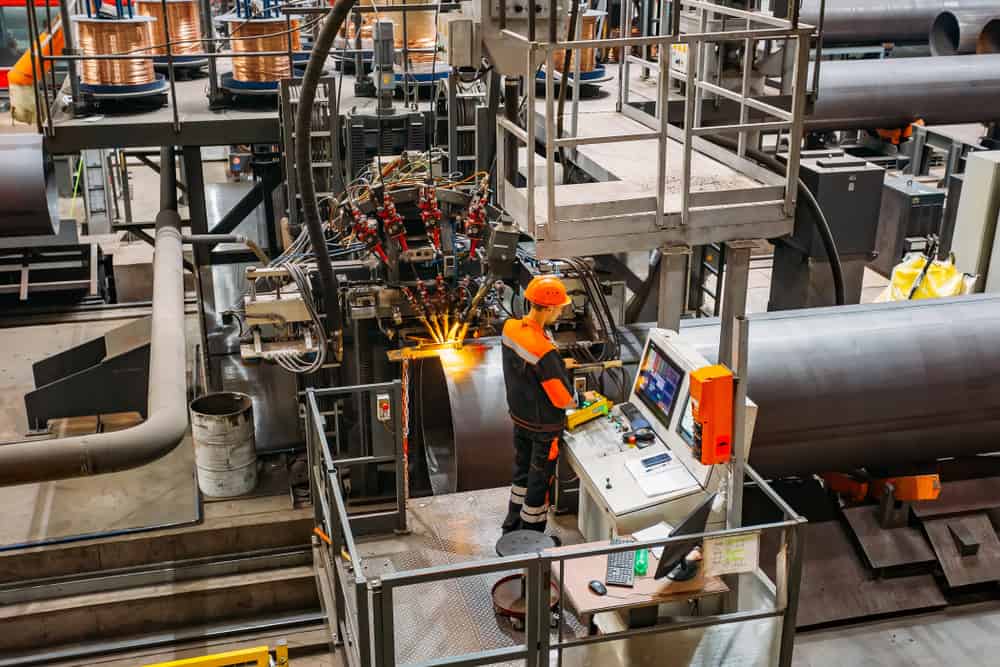
The fabrication of tubes or piping systems requires precise welding around the circumference to ensure the quality fusion of the material. Circumferential welding describes processes that can weld two cylindrical pieces by welding around their outer diameters to fuse and form a single entity. Circumferential welding, a term synonymous with orbital welding, has been preferred by welders for faster operation and higher quality welds devoid of defects.
Today, circumferential welding is suitable for joining a wide range of materials using different types of welding technologies. A detailed understanding of these welding processes is essential for welders to make ideal weld process selection for producing high-quality weld results.
Types of Circumferential Welding Processes
Different welding techniques are employed for the fusion of pipes or tubes. The types suitable for circumferential welding are discussed below:
Metal Inert Gas Welding (MIG): Also known as gas metal arc welding (GMAW), or wire welding, this welding process utilizes continuous wire feeding as the consumable electrode traveling along the circumference. The process includes a shielding gas that prevents any contaminants in the air from corrupting the weld quality. However, this need for purity can also be a drawback as environmental factors can influence the effectiveness of shielding gas and cause weld quality to diminish. Nevertheless, the relatively faster welding speed and increased deposition rates allow welders to achieve higher productivity.
Tungsten Inert Gas (TIG): Otherwise known as gas tungsten arc welding (GTAW), this welding process has been used by operators for welding ferrous and non-ferrous metals. The process utilizes a non-consumable tungsten electrode to create an arc and inert shielding gas to prevent oxidation and contamination. The process can be more complex when compared to other welding processes, but GTAW can perform purer and more consistent high-quality welds.
Laser Beam Welding (LBW): This welding process leverages a concentrated laser instead of a conventional electric arc as a heat source for creating a weld. Although it creates a smaller heat-affected zone, LBW depth of penetration is limited when compared to TIG welding. However, the process is effective in welding thin-walled materials.
Plasma Arc Welding (PAW): The plasma arc welding process is similar to TIG welding, as they both utilize a tungsten electrode to create an arc; however, a plasma arc is used to generate heat. Its arc control can produce excellent quality welds on thin to thick materials; however, it can create a comparatively larger heat-affected zone than TIG welding and can be costly.
For the strength and high-quality weld required for circumferential welding in tubes and pipes, GTAW can provide an ideal welding option. With excellent arc control, penetration, and consistency, it is possible to achieve clean and precise welds.
GTAW for Quality and Precision in Welding
The various advantages of GTAW provide excellent suitability in the circumferential welding of thin-walled pipes and tubes. The high degree of control enables the formation of a high-quality root profile, while the shielding gas enables the formation of a cleaner weld. When paired with a mechanized system, GTAW orbital welding can further improve the weld quality.
Compared to a manual process, the orbital GTAW processes offer a more optimizable solution. Orbital weld heads can easily mount to a track and perform circumferential welding along the internal and external diameters of the pipes. Orbital GTAW allows optimization and monitoring of weld parameters, enabling controlled welding for each pass. Additionally, automated welding capabilities allow welders to remotely monitor the otherwise physically taxing process, especially in large diameter pipes. And by removing the potential for human error, orbital welding can continuously perform the weld with greater speed, purity, and control.
Reliability and Quality in Circumferential Welding With GTAW
Among the various circumferential welding processes, GTAW provides the greater benefits to weld quality and consistency. Additionally, the automated process can help manufacturers achieve a new level of productivity. Orbital GTAW proves the best choice as it enables manufacturers to save costs and increase speed while ensuring quality and reliability in circumferential welding.
Arc Machines, Inc., a leader in GTAW orbital welding technology, offers a wide range of orbital weld heads and power supplies for your circumferential welding applications. For inquiries regarding products, contact sales@arcmachines.com. For service inquiries, contact service@arcmachines.com. Contact us to arrange a meeting.




